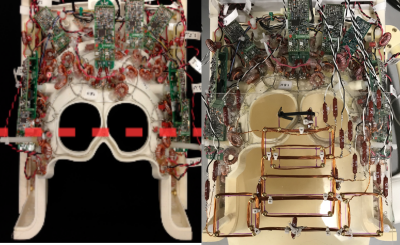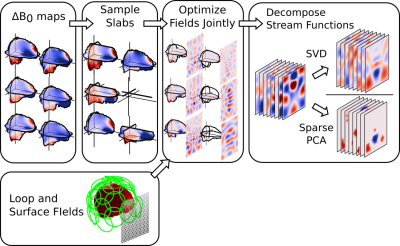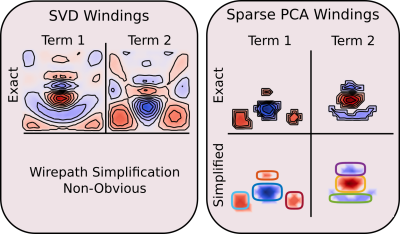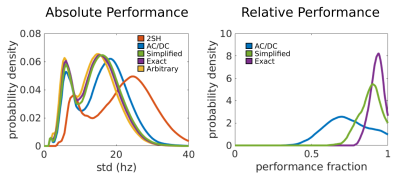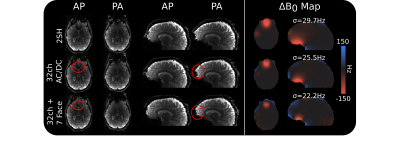4224
Computational Shim Coil Design Applied to Augmenting a Shim Array with a Non-Eye-Occluding Face Plate1Department of Electrical Engineering and Computer Science, Massachusetts Institute of Technology, Cambridge, MA, United States, 2A. A. Martinos Center for Biomedical Imaging, Massachusetts General Hospital, Charlestown, MA, United States, 3Harvard Medical School, Boston, MA, United States, 4Institute for Medical Engineering and Science, Massachusetts Institute of Technology, Cambridge, MA, United States
Synopsis
Local multi coil shim arrays enable improved brain ΔB0 homogeneity shimming at low overall cost. We have developed tools for the computational design of additional local shim coils to augment existing shim arrays using sparse factorization techniques. A proof of concept seven channel face shim coil was designed and tested in vivo. This proof-of-concept shim coil shows promise for improving static field inhomogeneity in the pre-frontal cortex.
Introduction
Local multicoil shim arrays are a useful tool in improving human brain imaging performance [1, 2, 3, 4]. We propose a method for the semi-automated design of brain-specific shim coils to augment an existing multicoil array. We aim to improve shim performance by adding additional shim channels on a plate inferior to the eyes. Prior work hasdemonstrated the effectiveness of designing brain-inhomogeneity-specific shim coil geometries. We extend previously described coil design methods [6, 7, 8] to demonstrate a simple-to-fabricate shim loops augment the 32-channel AC/DC shim array. Figure 1 shows the 32 channel AC/DC shim array [5] with and without the additional faceloops designed with the method described in this work.Methods
The proposed method for designing practically constructible shim coils begins with the assembly of a large dictionary of brain-specific shim settings for many individuals. Volumes of random thickness and position are sampled from database of ΔB0 maps from the Human Connectome Project [9]. To design a coil to augment the capabilities of an existing shim loop array, stream functions over the desired current carrying surface and currents through the existing loop geometry are jointly optimized over the sampled volumes. The dictionary is then decomposed to compute the dominant stream functions over the population of sampled brain ΔB0 maps. The described workflow is shown in figure 2. Typically, the singular value decomposition is used, but in this work we employ recently developed sparse principal component analysis [10] to design simple-to-fabricate coil geometries.Rather than producing an energy-sorted orthogonal basis for the stream function dictionary, sparse principal component analysis computes the dominant k-sparse components with no guarantees of orthogonality. The sparse SVD of the stream function shim-dictionary results in small clustered shim loops as seen in figure 3. While the dominant SVD and sparse-PCA terms share similar characteristics, the sparse decomposition admits simple wire-path discretization while The svd-based wirepaths are quite complex and would prove difficult to fabricate.
To simplify the wire-patterns we design a practically constructible shim coil by roughly placing independently controlled rectangular shim loop elements to approximately match the size and placement of the stream-function-derived loops each indicated with unique colors in figure 3.The 7 channel shim face-plate was fabricated according to the geometry of the loops in figure 4 with 10 windings per loop. Dual gradient echo ΔB0 field maps and EPI were acquired under global shims using second order spherical harmonic, AC/DC, and AC/DC plus 7 simplified face-loop shim bases with 3A current limits. EPI acquisition parameters: 74 slice 1.7x1.7x2 mm resolution TE=30ms TR=5s. Gradient Echo parameters: 1.7x1.7x2 mm resolution TE1=4.45ms TE2=6.92ms.
Results
Performance of the 7 channel shim plate was evaluated in simulation over a test population to verify the effectiveness of the simplified 7-channel face-loop design. Figure 4 shows probability distribution of the shimmed standard deviations for randomly sampled brain-slabs using second order spherical harmonic, 32 channel AC/DC, AC/DC plus 7 simplified face, AC/DC plus 7 exact, and AC/DC plus arbitrary surface current shim bases. Easy-to-shim slabs see little improvement through the addition of shim currents on the face-plate. However, significant performance improvement can be achieved through the use of face-plate currents for hard-to-shim slabs. The mean slab standard deviation of the hard-to-shim slices reduces from 18.1Hz to 15.3Hz through the addition of the exact 7 channel shim loops. The standard deviation is reduced reduced to 15.8Hz using the simplified 7 channel shim loops. The low performance gap between the exact and simplified wire paths is illustrated in the distribution of relative performance in which the fractional improvement between the baseline second order spherical harmonic shim and arbitrary face plate surface currents is shown. The complex 7 channel array achieves 93% of the performance of arbitrary surface currents on average while the simplified array mean fractional performance 87% of that achieved by arbitrary currents.Figure 5 shows the acquired EPI and ΔB0 maps from a single subject. Addition of the 7 channel shim face plate to the 32 channel AC/DC coil reduced whole head standard deviation from 25.5Hz to 22.2Hz. The face shim plate significantly reduces ΔB0 inhomogeneity in the pre-frontal cortex though it provides little benefit to field in the temporal lobes. The pre-frontal cortex T2* signal dropout and distortion in EPI is reduced with the areas of interest circled in red.
Discussion
The use of sparse PCA on a dictionary of joint shims over a large population has enabled the design of a simple face-plate shim array to reduce the sinus inhomogeneity in human brains, with little sacrifice in performance compared to more complex wire-patterns. Simulation results show performance improvements across a large population and artifact-free EPI with reduced dropout and distortion demonstrates the feasibility of coils designed through this method.The shim coil design method proposed is not limited to augmenting existing shim arrays and may be used to design stand-alone shim coil geometries. Further, with a suitable database of $\db$ maps, the method may be applied to shim anatomy other than the brain. Our computationally designed shim coil face plate is a viable proof-of-concept of carefully augmenting existing brain local multicoil shim arrays for improved performance.Acknowledgements
The authors graciously acknowledge the support of the Skolkovo Institute of Technology Next Generation Program MIT-MGH seed grant and NIH NIBIB R01EB018976
Data were provided in part by the Human Connectome Project, WU-Minn Consortium (Principal Investigators: David Van Essen and Kamil Ugurbil; 1U54MH091657) funded by the 16 NIH Institutes and Centers that support the NIH Blueprint for Neuroscience Research; and by the McDonnell Center for Systems Neuroscience at Washington University
References
[1] Hui Han, Allen W Song, and Trong-Kha Truong. Integrated parallel reception, excitation, and shimming(ipres). Magnetic resonance in medicine, 70(1):241–247, 2013.
[2] Irena Zivkovic, Tolstikhin Iliya, Bernhard Schoelkopf, and Klaus Scheffler. B0 shimming in a smallvolume at 9.4t – irregular coil geometry setup vs. loop coil setup. ISMRM, (4338), 2016.
[3] Han Hui, John Stager, Hsin-Jung Yang, Na Zhang, Sizhe Guo, Zhuoqi Li, Yicheng Wang, and DebiaoLil. Unified coils (unic) for simultaneous rf reception and targeted local b0 shimming. ISMRM, (4338),2016.
[4] Jason P. Stockmann and Lawrence L. Wald. In vivo B0field shimming methods for MRI at 7 T.NeuroImage, 168:71–87, mar 2018.
[5] Jason P. Stockmann, Thomas Witzel, Boris Keil, Jonathan R. Polimeni, Azma Mareyam, CristenLapierre, Kawin Setsompop, and Lawrence L. Wald. A 32-channel combined RF and B0 shim array for3T brain imaging. Magnetic Resonance in Medicine, 75(1):441–451, jan 2016.
[6] Nicolas Arango, Elfar Stockmann, Jason abd Adalsteinsson, and Jacob White. Ultimate b0 shim andthe design of optimal shim bases. ISMRM, (1462), 2019.
[7] Ali Aghaeifar, Jiazheng Zhou, Irena Zivkovic, Joshi Walzog, Joshi Memaj, Theodor Steffen, RahelHeule, Feng Jia, Maxim Zaitsev, and Klaus Scheffler. A 32-channel multi-coil shim setup optimized forthe human brain, pushing the limits of shimming at 9.4t. ISMRM, (1462), 2019.
[8] Mustafa Kaan Çan, Pei-Yan Li, Jiazheng Zhou, Pu-Yeh Wu, Yi-Tien Li, Risto Ilmoniemi, and Fa-HsuanLin. Designs of shim coils with distributed currents for 3t human brain magnetic resonance imaging.ISMRM, (1471), 2019.
[9] David Van Essen, Kamil Ugurbil, E Auerbach, D Barch, TEJ Behrens, R Bucholz, Acer Chang, LiyongChen, Maurizio Corbetta, Sandra W Curtiss, et al. The human connectome project: a data acquisitionperspective. Neuroimage, 62(4):2222–2231, 2012.
Figures
